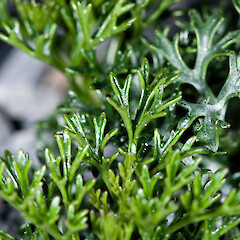Clematis marmoraria
Common name
North-west Nelson marble clematis
Synonyms
None (described in 1975)
Family
Ranunculaceae
Flora category
Vascular – Native
Endemic taxon
Yes
Endemic genus
No
Endemic family
No
Structural class
Lianes & Related Trailing Plants - Dicotyledons
NVS code
The National Vegetation Survey (NVS) Databank is a physical archive and electronic databank containing records of over 94,000 vegetation survey plots - including data from over 19,000 permanent plots. NVS maintains a standard set of species code abbreviations that correspond to standard scientific plant names from the Ngä Tipu o Aotearoa - New Zealand Plants database.
CLEMMR
Chromosome number
2n = 16
Current conservation status
The conservation status of all known New Zealand vascular plant taxa at the rank of species and below were reassessed in 2017 using the New Zealand Threat Classification System (NZTCS) – more information about this can be found on the NZTCS website. This report includes a statistical summary and brief notes on changes since 2012 and replaces all previous NZTCS lists for vascular plants.
Please note, threat classifications are often suggested by authors when publications fall between NZTCS assessment periods – an interim threat classification status has not been assessed by the NZTCS panel.
- Conservation status of New Zealand indigenous vascular plants, 2017 . 2018. Peter J. de Lange, Jeremy R. Rolfe, John W. Barkla, Shannel P. Courtney, Paul D. Champion, Leon R. Perrie, Sarah M. Beadel, Kerry A. Ford, Ilse Breitwieser, Ines Schönberger, Rowan Hindmarsh-Walls, Peter B. Heenan and Kate Ladley. Department of Conservation. Source: NZTCS and licensed by DOC for reuse under the Creative Commons Attribution 4.0 International licence.
2017 | Threatened – Nationally Vulnerable | Qualifiers: CD, OL
Previous conservation statuses
2012 | Threatened – Nationally Vulnerable | Qualifiers: CD, RR
2009 | Threatened – Nationally Vulnerable | Qualifiers: CD, RR
2004 | Gradual Decline
Distribution
Endemic. New Zealand: South Island (Confined to two sites within north west Nelson, Kahurangi National Park).
Habitat
Alpine marble karrenfield where it grows in either in crevices in massive marble, or amongst semi-fixed rocks, stones and similar rocky sites in open herbfield
Detailed description
A low rupestral dioecious subshrub with slender taproot and several stems, spreading in suitable habitats by a succession of suckers. Stems perennial, c.1-2 mm diameter, up to 500 mm long, almost or quite glabrous and inconspicuously grooved. Underground part of suckers 40-500 mm long with 2-14 pairs of much reduced leaves (internodes 1-60 mm long); usually rooting and branching at some nodes. Aerial stems erect to decumbent, very short (40-100 mm) but longer in shade, internodes 1-40 mm long; usually sparingly branched. Underground leaves 1-5 mm long, entire to minutely lobed. Green leaves ± crowded, subcoriaceous to coriaceous, almost glabrous, up 40 mm long, living c.2 years before slowly decaying to base. Petioles 5-18 mm long, channelled, not twining. Laminae broad-ovate to angular-ovate in outline when fresh, variously dissected (with major segments ± ascending and overlapping) from multifid-multipartite to deeply 3-lobed to 3-foliolate; lobes or leaflets deeply incised 2-3 times (to bipinnate below in leaflets), upper surface of segments concave and ± bordered, ultimately small, obtuse to subacute; lateral leaflets short petioluled, oblique at base. Subfloral leaves 3-21 mm long. Inflorescence a solitary flower, axillary, ± fulvous pubescent; peduncles 25-75 mm long; bracts 1-2 pairs –lower pair (often lacking) basal, connate, blade c.2 mm long, minutely 3-lobed - upper pair 2.0-7.7 mm long, narrow-oblong to spathulate, entire or shallowly lobed. Male flower 20-30 mm diameter; sepals 5-8, white (slightly green-stained when young), thinly fulvous-silky without, glabrous within, 6-18 × 3.0-10.5 mm, obovate (occasionally elliptic); stamens 20-50, 5-9 mm long, anthers 1.0-1.8 mm long, ovate-oblong, connective produced into minute blunt apiculus; carpels 0. Female flower with slightly smaller sepals; stamens 8-13, anthers barren; carpels 20-50. Achene seed body ovoid, 3-4 mm long, puberulent, brown; style 15-30 mm long, pale fulvous-plumose
Similar taxa
Distinguished from all other New Zealand Clematis (indigenous or naturalised) by the restriction to marble subalpine to alpine habitats, by tufted suckering shrublet growth habit; non twining petioles; and by the flowers which have pure white or faintly greenish-yellow, obovate-elliptic sepals.
Flowering
December
Flower colours
White
Fruiting
January - March
Life cycle
Pappate achenes are dispersed by wind (Thorsen et al., 2009).
Propagation technique
Can be grown from cuttings and fresh seed. Slow growing and best kept in a deep, well drained pot within an alpine house, except in cooler climates. Does best in lime rich soils.
Threats
Apparently confined to only two sites at which it remains vulnerable to animal (goat, deer) browse.
Etymology
clematis: From the Greek klema ‘vine’, alluding to the vine-like habit of many species
Where To Buy
Occasionally available from some specialist native plant nurseries. This species has been hybridised with several of the other New Zealand species ot produce a range of cultivars now popular with gardeners are widely available from garden centres.
Attribution
Description from Sneddon (1975)
References and further reading
Sneddon, B.V. 1975: A new Clematis from North-west Nelson, New Zealand. New Zealand Journal of Botany 13: 557-65.
Thorsen, M. J.; Dickinson, K. J. M.; Seddon, P. J. 2009. Seed dispersal systems in the New Zealand flora. Perspectives in Plant Ecology, Evolution and Systematics 11: 285-309







